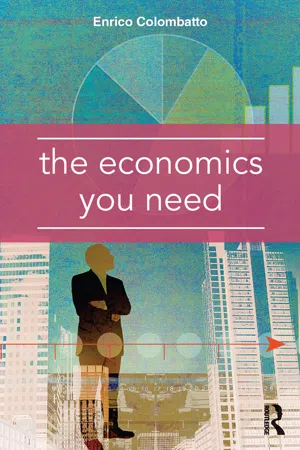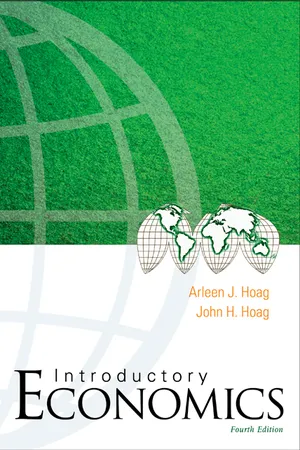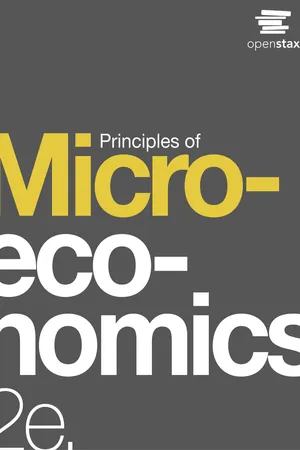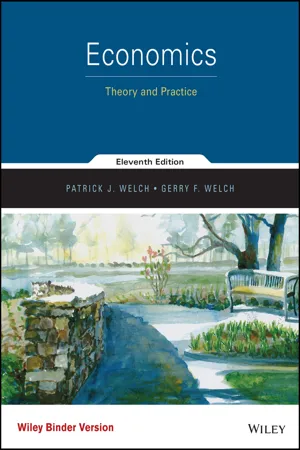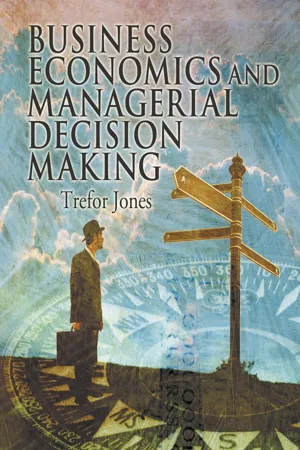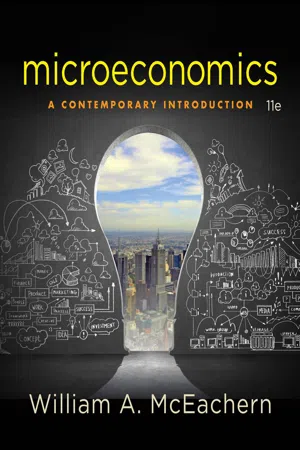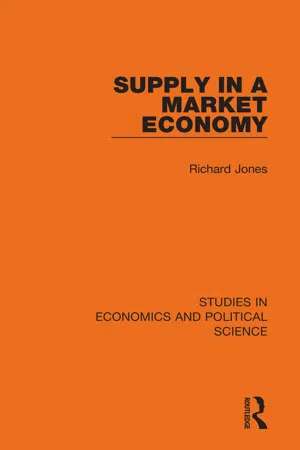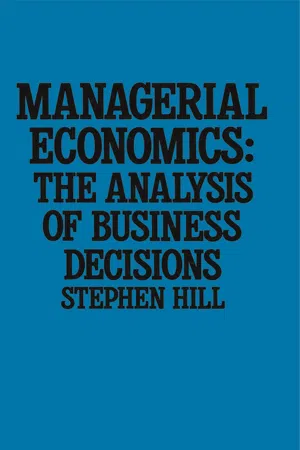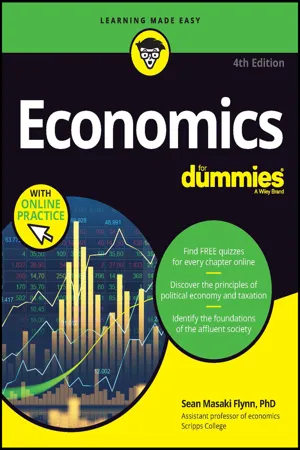Economics
Average Cost
Average cost refers to the total cost of production per unit of output. It is calculated by dividing the total cost by the quantity of output produced. This metric is important for businesses to determine the cost efficiency of their production processes and to make pricing decisions.
Written by Perlego with AI-assistance
Related key terms
1 of 5
12 Key excerpts on "Average Cost"
- eBook - ePub
- Enrico Colombatto(Author)
- 2016(Publication Date)
- Taylor & Francis(Publisher)
The notion of total costs is helpful. It provides an effective synthesis of the outcomes generated by the producers’ choices aiming at efficiency broadly understood, and it is the benchmark with respect to which competitiveness is assessed, since the nearer the firm is to its total-cost curve, the better its short-run position in the industry and its chances to make profits or contain losses. In this and the following sections, we shall go one step further and show that closer inspection of the firm's cost structure also provides useful insights about how producers determine the profit-maximising level of output, about when it pays to stop producing and wait for better times, and about when it is advisable to liquidate the company and quit the industry altogether. Here, however, economics usually departs from total-cost curves, preferring instead to focus on ‘Average Costs’ and ‘marginal costs’. To these categories we now turn our attention.Average Cost is total cost divided by the quantity of output. In other words, Average Cost is the cost per unit of output. Of course, since total costs are the sum of fixed and variable costs, Average Cost is the sum of average fixed cost and average variable cost. This is illustrated in Figure 4.2 , in which the dashed lines describe average fixed and variable costs, and the continuous lines are average (total) cost. Note that the average fixed-cost curve represented in the figure slopes downward until X1 , the threshold beyond which a new wave of fixed costs needs to be incurred – for example, to increase production capacity. Until that point (X1 ), an increase in output means that a given amount of (fixed) initial costs is spread over larger and larger amounts of goods and services and that, therefore, the burden of such costs per each unit of output becomes lighter and lighter.Figure 4.2 Average Cost curvesBy contrast, average variable cost curves are usually U-shaped. Two things account for this. The first relates to the fact that for low volumes of output, production factors cannot always be fully utilised (e.g., downtime phenomena are frequent). Moreover, an employer operating a small company might have weak bargaining power when hiring inputs or looking for funds to finance operations. When present, such difficulties thus translate into relatively high variable costs per unit of output. However, average variable costs tend to decline as output expands: production factors are put to better use and – perhaps – the entrepreneur's bargaining power strengthens, so that he can employ inputs at a lower cost. Yet, size leads to downward-sloping average variable costs only to a point, beyond which large-scale enterprises are no longer the lowest-cost producers. This phenomenon is due to the presence of a second element of variable costs: organisation and monitoring. Monitoring is necessary to ensure that inputs operate properly, that coordination remains nimble and effective, and shirking is kept within tolerable limits. Typically, the cost of monitoring increases – and its effectiveness decreases – with the size of the company. For example, you may need one supervisor to monitor a team of 15 workers, but three supervisors to coordinate two teams of 15 workers each – one for each team and a senior supervisor to coordinate the teams and the junior supervisors. Furthermore, as the size of the firm increases, the feelings of loyalty and within-group solidarity tend to weaken, which adds to the cost of monitoring. Thus, when the benefits created by more effective exploitation of inputs and stronger bargaining power are outweighed by high monitoring costs and low motivation, average variable costs start increasing. Put differently, one may conjecture that for low volumes of production (until X0 , in our example), size prevails and exerts a downward pressure on average variable costs, which decrease as output increases. For high volumes of production (beyond X0 - eBook - ePub
- Arleen J Hoag, John H Hoag(Authors)
- 2006(Publication Date)
- WSPC(Publisher)
and implicit costs associated with production. Next we rearrange the total cost into two useful cost concepts, average and marginal.Average CostOnce the total cost is known, you can use a simple process to find the Average Cost. This is the familiar process you use to find your average test score at the end of the term. First add the points per test to find the total points; then divide the total by the number of tests. This is the same process as finding a total cost and dividing by the level of output. The group of Average Costs is composed of average fixed cost, average variable cost, and average total cost. The first to be discussed is average fixed cost.The average fixed cost (AFC) is the total fixed cost divided by the number of units produced. The result is the fixed cost per unit of output.Look at Table 10-4, which contains the data for the entire Average Cost group. At the third unit of output, average fixed cost is $20 per unit (TFC of $60/3) and is $10 per unit to produce 6. Figure 10-4 shows the shape of the average fixed cost curve. The downward-sloping curve clearly indicates that the average fixed cost always declines with an increase in output. This continuous decline is due to the constant fixed cost being shared by more and more units of output. The result is a smaller fixed cost per unit. This compares to what a businessperson calls “spreading the overhead.” Since rent, for example, remains the same regardless of the amount of production, this fixed cost is shared equally by the output.Table 10-4 Total and Average CostsThis table shows the Average Costs. Since the Average Costs are calculated from the total costs, the total costs are also shown. The average fixed cost is the total fixed cost divided by output. The average variable cost is the total variable cost divided by output. The average total cost is the total cost divided by output. You should also see that the average total cost is the sum of the average fixed and the average variable cost. - eBook - PDF
- Steven A. Greenlaw, Timothy Taylor, David Shapiro(Authors)
- 2017(Publication Date)
- Openstax(Publisher)
However, the Average Cost is $320/40, or $8. If you graphed both total and Average Cost on the same axes, the Average Cost would hardly show. Average Cost tells a firm whether it can earn profits given the current price in the market. If we divide profit by the quantity of output produced we get average profit, also known as the firm’s profit margin. Expanding the equation for profit gives: average profi = profi quantity produced = total revenue – total cost quantity produced = total revenue quantity produced – total cost quantity produced = average revenue – Average Cost 168 Chapter 7 | Production, Costs, and Industry Structure This OpenStax book is available for free at http://cnx.org/content/col12170/1.7 However, note that: average revenue = price × quantity produced quantity produced = price Thus: average profi = price – Average Cost This is the firm’s profit margin. This definition implies that if the market price is above Average Cost, average profit, and thus total profit, will be positive. If price is below Average Cost, then profits will be negative. We can compare this marginal cost of producing an additional unit with the marginal revenue gained by selling that additional unit to reveal whether the additional unit is adding to total profit—or not. Thus, marginal cost helps producers understand how increasing or decreasing production affects profits. A Variety of Cost Patterns The pattern of costs varies among industries and even among firms in the same industry. Some businesses have high fixed costs, but low marginal costs. Consider, for example, an internet company that provides medical advice to customers. Consumers might pay such a company directly, or perhaps hospitals or healthcare practices might subscribe on behalf of their patients. Setting up the website, collecting the information, writing the content, and buying or leasing the computer space to handle the web traffic are all fixed costs that the company must undertake before the site can work. - eBook - PDF
Economics
Theory and Practice
- Patrick J. Welch, Gerry F. Welch(Authors)
- 2016(Publication Date)
- Wiley(Publisher)
Total fixed cost is the same regardless of how much is produced; total variable cost increases as output increases. Average total cost is the cost per unit of output at a given level of production and is found by dividing total cost by the number of units of output produced. Marginal cost is the change in total cost resulting from the production of an additional unit of output. 6. In the short run, total cost increases slowly at low levels of output and rapidly at high levels of output. Average total cost decreases and then increases, as does marginal cost. These patterns are the result of the way in which variable factor usage increases as production increases. At low levels of output, small amounts of variable factors are needed with the fixed factors, and at high levels of output, large amounts of variable factors are needed to compensate for the limits imposed by the fixed factors. 7. Underlying the patterns of short‐run costs is the Law of Diminishing Returns, which says that as a variable factor of production is added to fixed factors, beyond some point the additional product from each additional unit of the variable factor will decrease. 8. Long‐run average total cost illustrates the pattern of costs in the long run. The shape of the long‐run average total cost curve is the result of economies of scale that occur in the early stages of long‐run production and cause the cost per unit of output to drop, constant returns to scale where average total cost stays the same, and diseconomies of scale that occur in the late stages of long‐run produc- tion and cause the cost per unit of output to increase. Summary Review Questions 327 1. What is a producing sector? Give some examples. How does this differ from the industry classification? 2. A friend believes that, as far as the costs of operating a business are concerned, short‐run costs are the costs that are incurred within the current year and long‐ run costs are those spread over more than a year. - eBook - PDF
- Rhona C. Free(Author)
- 2010(Publication Date)
- SAGE Publications, Inc(Publisher)
Cost Curves Economists have had a difficult time obtaining accurate cost data. In the first place, accounting data never include the implicit costs that are so important in economic decision mak-ing. Second, firm and industry data, when they are available, are collected on a fiscal year basis. Rarely does this coincide with either the short- or long-run time periods of economic analysis. Third, inputs are often used in different ways to pro-duce different products. This makes it difficult to assign costs specifically to the production of any one good or service. Nevertheless, costs, like production functions, have been studied widely. The results (Mansfield, 1997), while even more widely dispersed than production function estimates, are very interesting. Studies of long-run Average Cost, across a wide range of industries, over a long period of time, show little evidence of decreasing returns to scale. Rather than sug-gesting that decreasing returns rarely occur, it is more likely that when they become evident, entrepreneurs act quickly to eliminate them by reducing the scale of operations and per-haps creating separate companies. Several studies, across a wide range of industries, indi-cate that long-run Average Costs may be L-shaped but with the horizontal portion of the L extended out to the right. That is, the industry first experiences increasing returns to scale, and then as it grows enjoys constant long-run Average Costs (and constant returns to scale) over a wide range of output. A fewer number of studies suggest that increasing returns to scale are evident. This implies that the long-run Average Cost curve is negatively sloped. If an industry is experiencing increasing returns to scale, there is a strong incentive (as long as there is sufficient demand for the product) to increase the scale of operations because rev-enues are increasing and Average Costs are falling. - Trefor Jones(Author)
- 2004(Publication Date)
- Wiley(Publisher)
g To allocate ¢xed costs between the two products on the relative use made of the ¢xed factors by both products, measured by time used or output produced. g To allocate ¢xed costs on an arbitrary basis. Weighted Average Cost An Average Cost of production for the ¢rm as a whole also requires some agreement about the nature of the unit of output. If the two products are produced in ¢xed proportions, then the concept of weighted Average Cost can be used. However, for every proportion in which output might be produced there would be a separate Average Cost. The weighted Average Cost (AC w ) is calculated in the following way: AC w ðQÞ ¼ F þ c 1 ðX 1 QÞ þ c 2 ðX 2 QÞ Q where X 1 and X 2 are the proportions in which products 1 and 2 are produced, or the weights used in calculating Average Costs, and Q ¼ the total output. If the two products are initially produced in equal numbers, then if the variable cost for product 1 is 2Q 1 , for product 2 it is 3Q 2 , ¢xed costs are 200, output is 100 and the total cost function is given by: TC ¼ 200 þ 2ð0:5 QÞ þ 3 ð0:5 QÞ Total cost for an output of 100 is given by: TC ¼ 200 þ 2ð0:5 100Þ þ 3 ð0:5 100Þ ¼ 450 with a weighted Average Cost equal to 4.5. The total cost for an output of 200 with the same proportions of products would be 700, and the weighted Average Cost would be 3.5. If the proportions of the two products were to change to 0.3 for product 1 and 0.7 for product 2, then the total cost function for an output of 100 would be: TC ¼ 200 þ 2ð0:3 100Þ þ 3 ð0:7 100Þ ¼ 470 with Average Cost equal to 4.7. If output were 200, then total cost would be 760 and Average Cost 3.8. Marginal cost The concept of marginal cost only has meaning for an individual product if the output of the other product is held ¢xed. Thus, if the output of product 1 is held constant, 152 PART III g UNDERSTANDING PRODUCTION AND COSTS- eBook - PDF
- Colin Harbury(Author)
- 2014(Publication Date)
- Pergamon(Publisher)
In the short run, the existence of fixed costs means that the AVERAGE (or UNIT) TOTAL COSTS (A.T.C) of production start to fall, as fixed costs are spread over larger outputs, until a point is reached where the fixed supply of a factor begins to push A.T.C. up. This gives rise to what is known as the 'U-SHAPED' COST CURVE. AVERAGE FIXED COSTS (A.F.C.) fall as output expands. AVERAGE VARIABLE COSTS (A.V.C.) tend to be U-shaped in the short-run (owing to the Principle of Diminishing Returns; see next chapter). It should be added that falling costs may be INTERNAL to the firm, or EXTERNAL, where they are due to expansion of the whole industry. When output is such that A.T.C. are at a minimum the firm is sometimes said to be of OPTIMUM SIZE, though it should be noted that this is not necessarily its most profitable output. A firm maximizes profits, or minimizes losses, by producing that output where the addition to total cost which it incurs by producing one more unit is neither more nor less than the addition to the total revenue which it receives from sales. That is to say, MARGINAL COST (M.C.) is equal to MARGINAL REVENUE (M.R.). If also AVERAGE REVENUE (A.R.) is not less than A.T.C. this will be its long-run equilibrium position and ensure that the firm continues in business, since A.T.C. is defined to include the NORMAL PROFITS (or the opportunity cost of capital) necessary to keep the firm in the industry. In the short run, however, the firm will not shut down unless A.R. is also less than A.V.C. The behaviour of a firm depends not only on its costs but also on the market situation in which it operates. Two limiting cases are usually referred to initially — PERFECT COMPETITION and MONOPOLY. Perfect competition has the distinguishing feature that firms are PRICE TAKERS, i.e. each is faced with a price over which it has no influence whatsoever. Such a situation would follow from more than one set of assumptions. - eBook - PDF
Microeconomics
A Contemporary Introduction
- William A. McEachern(Author)
- 2016(Publication Date)
- Cengage Learning EMEA(Publisher)
Based on what happens to marginal cost, the total cost curve can be divided into two sections: 1. Because of increasing marginal returns from labor, marginal cost at first declines, so total cost initially increases by successively smaller amounts and the total cost curve becomes less steep. 2. Because of diminishing marginal returns from labor, marginal cost starts increasing after the ninth unit of output, so total cost increases by successively larger amounts and the total cost curve becomes steeper. Keep in mind that economic analysis is marginal analysis. Marginal cost is the key to economic decisions. Marginal cost indicates how much total cost increases if one more unit is produced or how much total cost drops if production declines by one unit. 7-3b Average Cost in the Short Run Although marginal cost is of most interest, the Average Cost per unit of output is also useful. We can distinguish between average variable cost and average total cost. marginal cost The change in total cost resulting from a one-unit change in output; the change in total cost divided by the change in output, or MC 5 D TC/ D q Copyright 2017 Cengage Learning. All Rights Reserved. May not be copied, scanned, or duplicated, in whole or in part. Due to electronic rights, some third party content may be suppressed from the eBook and/or eChapter(s). Editorial review has deemed that any suppressed content does not materially affect the overall learning experience. Cengage Learning reserves the right to remove additional content at any time if subsequent rights restrictions require it. 150 Part 2 Introduction to the Market System EXHIBIT 5 Total and Marginal Cost Curves for Smoother Mover In panel (a), fixed cost is $200 at all levels of output. Variable cost starts from the origin and increases slowly at first as output increases. As the variable resource generates diminishing marginal returns, variable cost begins to increase more rapidly. - eBook - PDF
Economics
A Contemporary Introduction
- William A. McEachern(Author)
- 2016(Publication Date)
- Cengage Learning EMEA(Publisher)
Based on what happens to marginal cost, the total cost curve can be divided into two sections: 1. Because of increasing marginal returns from labor, marginal cost at first declines, so total cost initially increases by successively smaller amounts and the total cost curve becomes less steep. 2. Because of diminishing marginal returns from labor, marginal cost starts increasing after the ninth unit of output, so total cost increases by successively larger amounts and the total cost curve becomes steeper. Keep in mind that economic analysis is marginal analysis. Marginal cost is the key to economic decisions. Marginal cost indicates how much total cost increases if one more unit is produced or how much total cost drops if production declines by one unit. 7-3b Average Cost in the Short Run Although marginal cost is of most interest, the Average Cost per unit of output is also useful. We can distinguish between average variable cost and average total cost. marginal cost The change in total cost resulting from a one-unit change in output; the change in total cost divided by the change in output, or MC 5 DTC/Dq Copyright 2017 Cengage Learning. All Rights Reserved. May not be copied, scanned, or duplicated, in whole or in part. Due to electronic rights, some third party content may be suppressed from the eBook and/or eChapter(s). Editorial review has deemed that any suppressed content does not materially affect the overall learning experience. Cengage Learning reserves the right to remove additional content at any time if subsequent rights restrictions require it. 150 Part 2 Introduction to the Market System EXHIBIT 5 Total and Marginal Cost Curves for Smoother Mover In panel (a), fixed cost is $200 at all levels of output. Variable cost starts from the origin and increases slowly at first as output increases. As the variable resource generates diminishing marginal returns, variable cost begins to increase more rapidly. - eBook - ePub
- Richard Jones(Author)
- 2021(Publication Date)
- Routledge(Publisher)
Marginal cost1 100 20.0 120 100.0 20.0 120.0 - 2 100 35.0 135 50.0 17.0 67.5 15.0 3 100 40.0 140 33.3 13.3 47.0 10.0 4 100 50.0 150 25.0 12.5 39.0 10.0 5 100 60.0 160 20.0 12.0 32.0 10.0 6 100 70.0 170 16.7 11.7 28.3 10.0 7 100 80.0 180 14.3 11.4 25.7 10.0 8 100 91.3 191.3 12.5 11.3 23.9 11.3 9 100 104.0 204 11.1 11.5 22.6 13.0 10 100 120.0 220 10.0 12.0 22.0 16.0 11 100 138.0 238 9.1 12.5 21.6 18.0 12 100 157.0 257 8.3 13.0 21.4 19.0 13 100 177.0 277 7.7 13.4 21.3 20.0 14 100 198.0 298 7.1 13.6 21.0 21.0 15 100 220.0 320 6.7 14.1 21.3 22.0 16 100 245.0 345 6.3 15.1 21.6 25.0 17 100 275.0 375 5.9 16.0 22.0 30.0 18 100 315.0 415 5.6 17.5 23.0 40.0 19 100 350.0 450 5.3 18.5 24.0 45.0 20 100 400.0 500 5.0 20.0 25.0 50.0Greater insight into cost relationship will be obtained by introducing the concepts of average and marginal cost. Average Cost is simply total cost divided by output. Average fixed cost (AFC) and average variable cost (AVC) are shown in columns 5 and 6 respectively. Average total cost (ATC) is shown in column 7. Since fixed costs are by definition a constant, it follows that average fixed costs must fall with an increase in output. This process is frequently described as spreading overheads (fixed costs are alternatively known as overhead or indirect costs). The Average Cost associated with any level of output is given by the slope of the line from the origin to the corresponding point on the total cost curve. Minimum Average Cost obtains at the output at which this ray from the origin is tangential to the curve of total cost.The final column of Table 3.1 contains marginal cost data. Marginal cost (MC - eBook - PDF
Managerial Economics
The Analysis of Business Decisions
- Stephen Hill(Author)
- 2016(Publication Date)
- Red Globe Press(Publisher)
Empirical studies of the long-run Average Cost curve are consider-ably more common. Walters 7 surveyed early studies with the general conclusion that long-run Average Cost generally declined as output expanded. Salvatore examined more recent American ex-perience, with the conclusions outlined in Table 7.5. Table 7.5 LRAC of small firms as a % of LRAC of large firms Industry % Hospitals Electric power Local airlines Railroads Trucking 129 112 100 100 95 Source: D. Salvatore (1986) Microeconomics: Theory and Applications (New York: Macmillan), p. 251. According to Table 7.5, large hospitals and power stations have a significant cost advantage over smaller units. In the provision of local air and rail communications, costs are the same for small and 180 Managerial Economics large firms, whilst small trucking com;anies have a cost advantage over larger hauliers. In India, Gupta found that long-run Average Cost curves were linear in six industries, U-shaped in five industries and L-shaped in eighteen industries. The major British study of the extent of economies of scale was by Pratten, 9 who found that long-run Average Costs were generally L-shaped implying that cost advantages disappeared at very large scale. Summary and conclusions The examination of costs for decision-making purposes relies heavi-ly on the notion of opportunity costs. However, some revision and adjustment of accounting costs are necessary before these can be used to approximate opportunity costs. The level of costs is determined by a number of variables including the different dimensions of output, input prices, and the state of technology. The economic theory of costs relates cost to the rate of output. In the short term, unit costs depend upon the productivity of the variable factor, whilst long-run Average Cost is influenced by the nature of returns to scale. - eBook - PDF
Economics For Dummies
Book + Chapter Quizzes Online
- Sean Masaki Flynn(Author)
- 2023(Publication Date)
- For Dummies(Publisher)
Focusing on marginal costs The preceding sections demonstrate how the manager of a firm can use data on total costs, fixed costs, and variable costs to calculate, respectively, average total costs, average fixed costs, and average variable costs. But what the manager really wants to know is what quantity, q, of output to produce to maximize profits. To solve this problem, the manager needs one more cost concept: marginal cost. Marginal cost is how much total costs increase when you produce one more unit of output. Crucially, the marginal cost of one more unit of output depends on how much output has already been produced. To see this, examine the total costs column of Table 6-1. Notice that total costs increase from $100 in the first row to $180 in the second row as output increases from 0 bottles to 50 bottles when the firm hires the first worker. In other words, costs go up $80 while output goes up by 50 bottles. So each of these extra, or mar- ginal, 50 bottles on average increases costs by $ $ . 80 50 1 60 each. The marginal cost per bottle, MC, is defined as follows: MC TC q change in change in (6) As you move down the marginal costs column of Table 6-1, you can see that mar- ginal costs first fall and then rise. This is yet another reflection of the fact that LemonAid Corporation’s production process exhibits increasing returns followed by diminishing returns. Because the second worker produces much more than the first worker but costs the same, the marginal cost falls when the second worker is added. For successive workers, costs keep increasing but marginal output keeps declining, which means marginal costs must rise.
Index pages curate the most relevant extracts from our library of academic textbooks. They’ve been created using an in-house natural language model (NLM), each adding context and meaning to key research topics.
